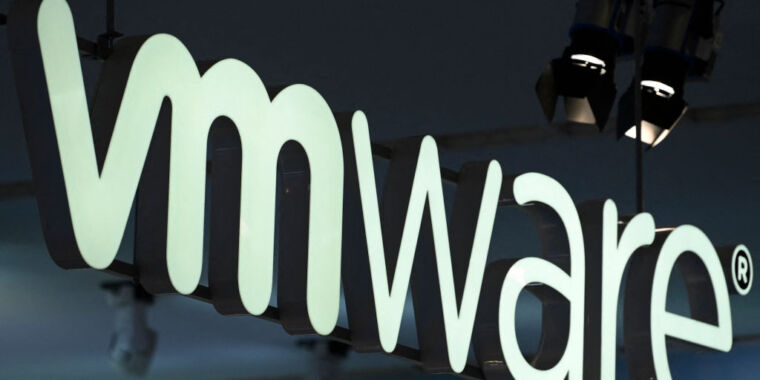You will own nothing, and you will like it.
lol, make me
I’m super glad I recently made the switch to XCP-ng for my home lab hypervisor.
I mostly use lightweight virtualization with containers and jails at home. I have one BHyVe VM, but I plan to eliminate virtualization completely. It’s a waste of resources for my setup.
Broadcom is one of the worst fuckin suppliers
One of?
You have to leave room for Oracle.
Obligatory: fuck Adobe
Solarwinds; never forget.
I feel like SAP takes the security-through-obscurity approach to not getting shit talked in these chains. As someone who has dealt with oracle, solarwinds, and sap, sap wins full stop.
SAP is evil incarnate. Their “consultants” are the worst form of con artists, and completely incompetent.
I hated working with SAP. It was such a malformed beast.
I used to root against the Golden State Warriors solely because they played at the Oracle Arena.
Fair reason
Say what you will about Oracle; at least VirtualBox is open source.
Broadcom is really really bad, but there’s a lot of competition in that space.
SaaS is a scam
Software as a scam
I think a lot of enterprises are going to look at RHEV and Proxmox now. Broadcom will squeeze so little out of VMware thinking they can convert per seat licenses, it’s baffling to me why they decided to do this. Do all these companies want to spend $2 to make $1 all the sudden?
Watch: in a year they’ll offload it to private equity.
I think a lot of enterprises are going to look at RHEV
I don’t think so, because:
Development of RHV has ceased and as of August 2020 the product is now only receiving maintenance updates, with extended life phase updates provided until 2026.[8] The successor to RHV is Red Hat’s OpenShift container platform.
https://en.wikipedia.org/wiki/Red_Hat_Virtualization
Proxmox
I’m no expert btw, but from what I understand (from speaking with others and researching for my own homelab setup) is that LXD/Incus is now the preferred solution over Proxmox. LXD is faster, the CLI is very good, it has a huge library of ready to run Linux distro images which is convenient, and it runs on top of your favorite distro, which makes it easy to install/setup, more flexible, and more compatible (Proxmox runs an old and custom kernel, which may not be fully compatible with new hardware).
Watch: in a year they’ll offload it to private equity.
and that’s the kiss of death for any company
Proxmox is a decent option, or just use kvm provisioning directly with ansible.
So many companies can’t do this.
The staffing, the network and storage changes.
The suggestion to just use KVM and ansible is rather tone def.
Sounds like someone with limited experience in the industry, honestly.
Any shop large enough that this is such a massive undertaking is large enough that the people who care about this aren’t the people making financial decisions.
The good news is this is horrendous for finance as well so unless you cut a deal for your licensing costs because you’re a titan, you’ll be switching.
Actually, KVM and Ansible are a big part of the industry. KVM as a hypervisor is widely acknowledged in enterprise environments. Meanwhile, Ansible provides great automation for system management tasks. Their combined use for virtualization management and provisioning is not just common but a best practice, backed by a plethora of successful deployments across various industries.
I’m well aware of both, been in the industry for over 20 years.
But you still don’t seem to comprehend the cost or difficulty of the change.
Frankly the support options don’t seem very good either.
Deployment is not even half the battle, ongoing support is where the troubles really come out.
deleted by creator
Proxmox is not a complete replacement for VMware. Proxmox still does not have a distributed resource scheduler or distributed power management for it’s cluster which means the only time a VM will move between nodes is if a node goes down.
There’s no official support for VDI within proxmox and all the third party tools are janky at best, definitely not ready for enterprise level deployments.
Nvidia does not officially support vGPUs on proxmox. You can get it working but it’s definitely not something you’d want to run on production.
I get why enterprise likes VMWare but KVM isn’t harder to deal with. I’ve always worked at smaller companies so this isn’t an expert opinion. But I’ve always felt like at the infrastructure level, it ends up being cheaper to hire experts and run the open source solution (assuming it’s mature and at feature parity) than pay licensing and support fees.
An expert in one thing will usually add to your company in other ways too. Talent > “solutions” in the long run.
I learned years ago that buying something from a big company instead of using a free open source solution is about aoutsourcing responsibility. Its about being able to sue a company about damages instead of hiring reliable personell to run and write fixes for foss software. Also insurance is much easier.
Not that I follow that advice, my company is still 99% foss software.
Exactly. All enterprise software pricing is about liability and how much blame you can put on the software vendor when everything goes wrong.
Of course, your company’s employees are still going to be the ones picking up the pieces but you get to tell your investors “actually it was VMWare’s fault”. And you can’t do that with OSS, even if you’re buying support.
Let me tell you about a large bank and two data centers operated using VMware and the type of talent the bank is able to hire and retain. A move away from VMware is a 5-year project involving hiring, retraining, design mistakes, budget overruns, and a lot of grey hair. The year was 2012. 7 years later, one DC converted to OpenStack, the project is shelved and the majority of th OpenStack DC gets converted back to VMware due to “OpenStack disaster.”
deleted by creator
The fundamental problem I have identified over the years I worked adjacent to this project is this. Most folks above the manager position are not technical. They’re typically some sort of BA. These kinds of folks do not easily comprehend the technical merits of different solutions. All sorts of errors stem from that. Errors in estimating risk, errors in estimating difficulty, but crucially errors in telling reality from fantasy, or truth from lies. Under this framework, the ability of the organization to hire technical people who know what they’re doing is more or less based on luck. This particular org struck luck with some hires and didn’t with most. So now we have a group of people who will build this thing, with only a few qualified people among the unqualified. Alright. A difficult design decision has to be made. There are two proposals. One from a qualified person. Another from an unqualified one. They’re both presented to a director or a VP for a final decision. The qualified person presents their design, pros, cons, etc. The unqualified one does the same, except they have an ace up their sleeve - confident lies. So they sprinkle those all around their design - everything is amazing, few cons if any, unicorns shitting rainbows and the lot. The decision maker cannot discern the lies from the truth. The unicorn design feels irresistible. It’s chosen. Its designer is promoted before its ill effects are ever realized. Now the competent folk don’t even get to present alternatives to the VP level. Eventually they’re tired of this shit and move to a place that is less corrupted.
This wasn’t confined to one project and a single set of people. It’s a general problem that transcends orgs and companies.
Removed by mod
But isn’t RHEV dead?
I work in hosting. We mostly use Proxmox for our Hypervisors which is already a step up from “bare” KVM in regards to convenience/ease of use (especially for High availability scenarios and the like) We also run VMWare and while I don’t love the “locked down you gotta do it the VMWare way” nature it’s often so much easier and the HA is mich more convenient. Also it has proper functionality for custom resourcing/access/billing.
Say what? Going back to only KVM in modern DCs is some crazy talk. If your org is small enough that KVM is even remotely an option, then I’d recommend running a cost/benefit analysis on whether hosting a small server farm on prem is even worthwhile.
But when you’re managing hundreds of servers with dozens of various purposes, FOSS solutions aren’t always tenable. And not using a mature, feature complete virtualization platform is just straight up masochistic, not to mention potentially dangerous from a security standpoint.
I agree that talent > solutions, but if you want to retain that talent, you have to make their lives not miserable at work, which means sometimes having to purchase solutions to make their lives easier.
Small and medium (and even large) companies investing in talent instead of commercial solutions is the solution to improving FOSS. I know it has downsides, as you stated, but there are significant upsides. FOSS is cheaper than a custom solution, and the company only has to pay for the modifications it wants to see. The whole community then benefits from their hard work adding features and maintaining the software.
I’m not saying that it’s the BEST idea for every company. All I’m saying is not to discount FOSS out of hand for these companies. There are significant advantages for companies that should be weighed against the cons. This kind of advocacy is also important in furthering the FOSS model.
Broadcom used to be a worthwhile company, but now their whole M.O. seems to be buying up mature solutions and price-gouging the companies that rely on those solutions. They sell off the parts they can’t price gouge with and then the solutions stagnate. They did it with CA, and again with Symantec, and now it’s VMware’s turn.
Broadcom’s business was making chips and this is a horizontal move into new territory. Baffling.
deleted by creator
They won’t
They could kill VMware while trying though. Seeing a worthy competitor rise through the ashes would be nice.
The enshittifications will continue until morale improves
but just think of the brief moment of incredible profits before people migrate to other options.
I first deployed ESX back in 2003 and from then on I was a huge fan of VMware. So, watching Broadcoms changes unfold is a little sad.
What i really wanted to ask is, for meduim to large enterprises that want on-prem infrastructures what are their options nowadays? I don’t work in this area any more so I’m out of touch.
Linux KVM. I’ve used it on bare metal production servers for years.
My bet is Nutanix is going to grow a lot over the next few years.
deleted by creator
for meduim to large enterprises that want on-prem infrastructures what are their options nowadays?
Proxmox probably comes the closest, there’s also…HyperV (gross)
Your option is Azure or AWS…
/s
I tasked my VAR to find out what our pricing is going to look like in 2024 when our support agreement is up. They said VMware is a mess right now, do t expect a response soon. I need time to migrate and decide if I’m sticking with on-prem or moving god damn workloads to some cloud. This is a fucking shitshow. I fucking hate shareholders.
Removed by mod
In my experience, Citrix offers a pretty viable alternative with xen if you want to stay on-prem
Can you name one peer that manages Citrix hypervisor?
Move to Citrix. You can even use their cloud management system to manage your on prem infrastructure. So that’s an easy first workload to shift.
Citrix is garbage, I work with it daily
Maybe you’re bigger than us? I run 80k virtual desktops and it’s not bad. Yes, their workspace client is fiddly as hell, and the VDA upgrade is hard, but the platform itself is solid.
It’s fiddly as hell and you need to be a wizard to actually fully know your way around it. There’s so many ways to skin the cat–better hope things are documented. Their support is also beyond worthless for anything beyond buying more time with your boss for you to troubleshoot. I’ve put in a few tickets for odd issues, never had them resolve a single one. Half the time the client software updates fix one thing but break another two.
I much prefer a VMware horizon linked clone setup for end user VDIs, issues are usually confined to one user when they happen with those in my experience. And I can just put them on a spare, then rebuild their VM with two or three clicks to cut down on troubleshooting.
Just curious–where are you hosting your vms? We have a handful that use azure, but most are running on prem esxi. I’m biased because I came in to nothing being documented
On prem. We haven’t done cloud yet.
My most trouble free environments are the azure ones. Servers spin up or down based on user count. It’s not cheap though.
Azure backups are the shit. Need to roll back to yesterday to pull a copy of a file? Log onto azure, go to backup section. Then you download an executable and get a key. Run it on your file server, and it mounts a copy of the disk as it was at backup time. So nice and easy.
Good god what a disaster of a company. They treat their customers as over glorified testers.
Good thing I just dumped them for proxmox.
Ah another company ruining the company they just acquired
Is anyone really shocked? They publicly stated months ago that 70% of VMware’s profits come from Fortune 500 companies and that’s what they would focus on.
We just renewed support for our socket based perpetual licences for 3 years. This gives us plenty of time to find an alternative solution.
I love VMware, but man are they being short sighted with this one.

























